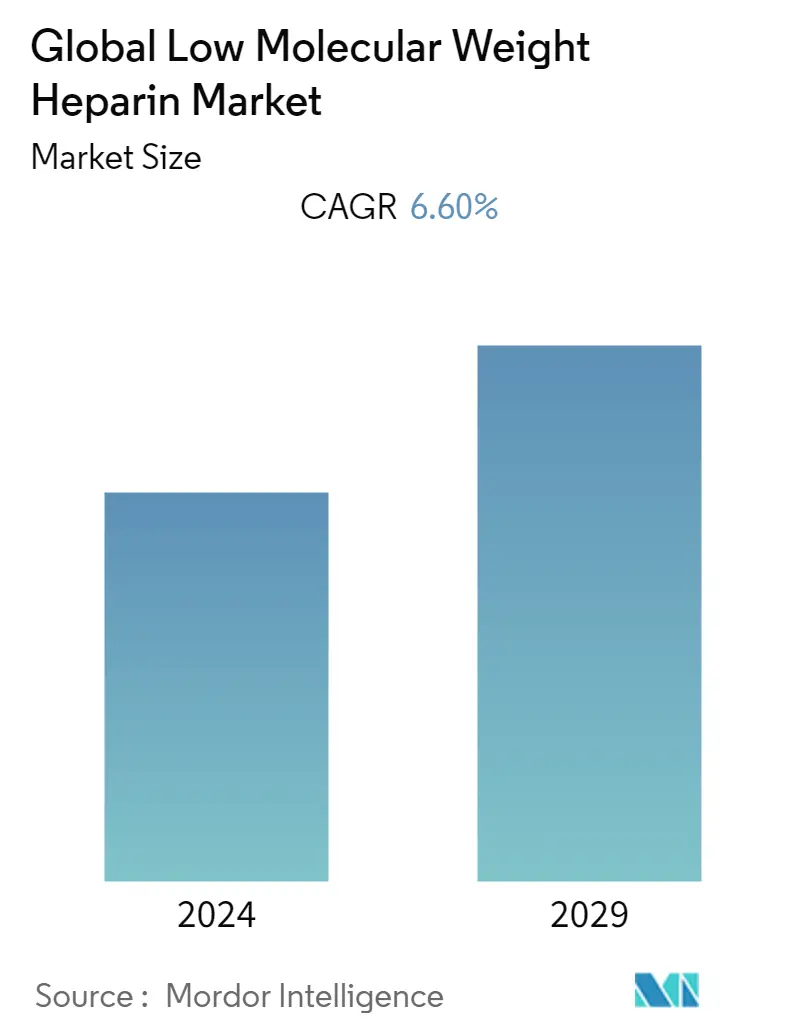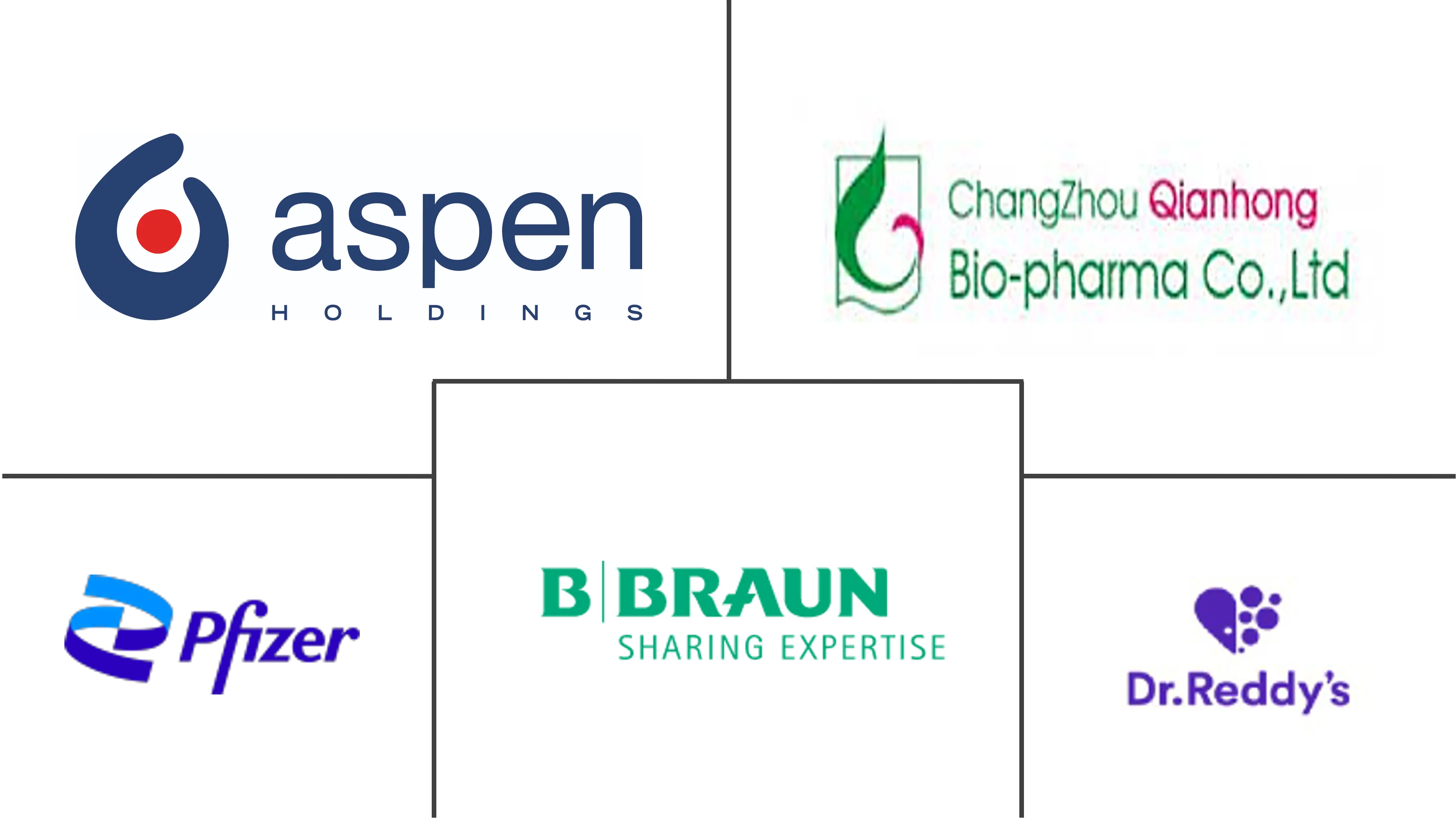Market Size of Global Low Molecular Weight Heparin Industry

| Study Period | 2019 - 2029 |
| Base Year For Estimation | 2023 |
| CAGR | 6.60 % |
| Fastest Growing Market | Asia-Pacific |
| Largest Market | North America |
| Market Concentration | Low |
Major Players
*Disclaimer: Major Players sorted in no particular order |
Need a report that reflects how COVID-19 has impacted this market and its growth?
Low Molecular Weight Heparin Market Analysis
The low molecular heparin market is expected to register a CAGR of 6.6% over the forecast period, 2022-2027.
The impact of COVID-19 on the low molecular heparin (LMWH) market was substantial in the initial phase owing to factors such as the closure of manufacturing facilities and research and development activities. However, the increasing use of LMWH in treating COVID-19 patients has accelerated the demand for LMWH products within the market. For instance, according to the PubMed Central (PMC) article titled "COVID-19, Low-Molecular-Weight Heparin, and Hemodialysis," published in May 2020, LMWH has antiviral characteristics in-vitro, and it is used in COVID-19 patients to prevent or delay coagulation cascade activation caused by inflammation. Disseminated intravascular coagulation and venous thromboembolism are two serious and potentially fatal complications. Moreover, there are currently many ongoing randomized controlled trials investigating the use of different heparin doses in patients with COVID-19. For instance, the clinical trial titled "a randomized controlled trial initiated in June 2020, comparing efficacy and safety of high versus low low-molecular-weight heparin dosages in hospitalized patients with severe COVID-19 pneumonia and coagulopathy not requiring invasive mechanical ventilation (COVID-19 HD): a structured summary of a study protocol" was to determine whether high doses of LMWH are effective in preventing thromboembolism, myocardial infarction, need for ventilation, and death. Thus, the abovementioned factors are likely to positively impact the adoption of LMWH among patients, ultimately driving the market growth over the pandemic phase.
The increasing prevalence of blood disorders and the introduction of LMWH anticoagulants are among the major factors driving the growth of the studied market. For instance, according to the Office of Disease Prevention & Health Promotion (ODPHP) data published in 2020, blood clots in leg veins affect roughly 1.2 million Americans yearly. This condition is called deep venous thrombosis (DVT). DVT is the most common preventable cause of death in hospitals, accounting for 10% of all deaths from pulmonary embolism (PE), which occurs when a blood clot from a vein in the leg travels to the lungs. Similarly, according to the Leukemia and Lymphoma Society (LLS) Factsheet 2021, one person in the United States is diagnosed with blood cancer approximately every three minutes.
Moreover, as per the same source, 186,400 people in the United States will be diagnosed with leukemia and lymphoma in 2021. In addition, 825,651 people lived with lymphoma in the United States; 152,671 people lived with Hodgkin's lymphoma, and 672,980 people lived with non-Hodgkin's lymphoma. As LMWH is extensively used in preventing blood clots and treating venous thromboembolism (deep vein thrombosis and pulmonary embolism), blood cancers, and the treatment of myocardial infarction, such an increase in the patient population will eventually drive the demand for low-molecular-weight heparin products.
Additionally, according to the National Institutes of Health (NIH) data published in February 2022, LMWH such as dalteparin and enoxaparin is used to prevent venous thromboembolic disease (VTE) during an acute or elective hospital stay, as well as to treat deep vein thrombosis (DVT) and pulmonary embolism (PE). As per the same source, over half of the patients admitted to hospitals who are severely ill are at risk of thromboembolic illness, and VTE is responsible for 5% to 10% of hospital mortality, necessitating accurate VTE risk assessment and effective treatment. Such instances will likely positively impact the market's growth over the forecast period.
In addition, new product approvals and strategic activities by major market players are augmenting the market's growth. For instance, in May 2021, Dr. Reddy's Laboratories Ltd. launched Ertapenem for Injection, one g/vial, a therapeutic equivalent generic version of INVANZ (ertapenem for injection). Likewise, in May 2020, Meitheal Pharmaceuticals Inc. received FDA approval for Enoxaparin Sodium Injection (USP), a generic equivalent of Lovenox, to prevent and treat harmful blood clots. Thus, due to product launches and acquisitions, the studied market is expected to grow significantly over the forecast period. Therefore, owing to the factors mentioned earlier, the studied market is anticipated to witness growth over the analysis period. However, the adverse effects of low molecular weight heparin are likely to impede the market growth.
